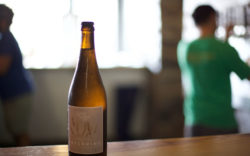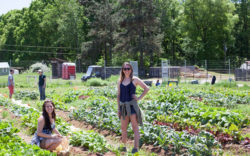The front lawn of Clarke Middle School is ripe with rows of organically grown produce—crops like kale, collards, arugula and parsley—things you’d expect to find on a local farm, but maybe not on the lunch tray of a seventh grader. The members of the school’s self-entitled “sustainability squad” aim to shift that paradigm on their own campus, throughout the district and ultimately on a global scale.
Debbie Mitchell and Hope Zimmerman give lessons on sustainable farming, cooking and eating. Mitchell, the agricultural sciences teacher, brings students into the garden—she teaches them to plant the seeds, to grow the crops and to harvest, using sustainable, organic practices. Zimmerman teaches family and consumer sciences, and she shows students how to cook nutritious food and improvise with what’s available, local and seasonal.
The teachers coordinate their curriculums to give students a holistic look at a sustainable food system. “We try to show the kids the connection,” says Zimmerman. “So, the students that I have now probably planted a lot of those seeds in the fall, and now they’re harvesting them and cooking them in my class. We stress the connection that this is where the food started, as a seed, and we planted and nurtured it, and now we’re going to consume it in my class.”
Wick Prichard is an AmeriCorp VISTA member whose main responsibility is to tend to the CMS garden. As such, he doesn’t have the traditional teaching setup. “The trash can is my desk,” says Prichard.
Each day, Prichard helps students redirect what they would otherwise put in the garbage into the compost pile or the recycling bin. When he’s able to divert untouched fruit or cartons of milk or juice from the trash, he gives them to students on free or reduced lunch who would like seconds that are not available on their meal plan. He also shares the reclaimed produce with Ms. Zimmerman, who uses it to cook in her class.
Of the fruit he’s salvaged Prichard says, “We’re up to like 800 or 900 oranges, something like 700 apples, something ridiculous like that, since October.”
The cafeteria hosts another chance for students to try foods grown in their school garden. A garden bar is also available to students, offering food from the garden that is prepared by the cafeteria staff.
“It’s another great way to make [the produce] available,” says Mitchell. “We need just as many opportunities as we can take to make it available to them to try new things.”
Many students are trying fruits and vegetables they’ve never had before or learning to like what they’d formerly found inedible.
“I like carrots more now,” says Ada Mitchell, a sixth-grader at Clarke Middle. “I didn’t like them as much before, because I always thought they looked gross and dirty, but they’re actually pretty good. And I like spinach and kale. And I like pesto, which is kind of like a mix of all the vegetables, and I didn’t think I would like that, so that’s good.”
The garden program also extends into a special education program. Teachers Jenn Thomas and Susan Fontaine lead these students as they tend to their own garden, starting their plants from seeds. Every Thursday, they use the produce they are growing in lunches they prepare for CMS teachers.
And at the helm of the sustainability squad’s effort is Principal Tad MacMillan. “He leads by serving,” says Mitchell.
“We have kids who are totally disconnected and don’t know anything about the garden, and then we have these kids who have become disconnected, but all of a sudden they start having conversations, and they’re like, ‘Oh yeah, my granddad did that,’” says MacMillan. “I think those are powerful experiences for our kids.”
For the second summer, student volunteers will harvest fruits and vegetables from the garden and serve them in their own miniature restaurant setting, staged in Zimmerman’s classroom. Celebrity chefs from Athens restaurants will moonlight, helping the kids write a menu and execute the meal with the produce they’ve prepped. Attendance grew last summer from five people in attendance to 60, and this year they expect more. One of the community’s truest examples of farm-to-table eating is available at the mere suggested donation of $10.
Hope Zimmerman’s Pesto Pasta
Yield: 6 servings
For the pesto:
-
2–3 cups basil
-
2 cloves of garlic
-
1/3 cup parmesan cheese
-
2/3 cup extra-virgin olive oil
-
1/2 tsp salt
-
1/4 tsp black pepper
-
1/4 cup pecans or walnuts (optional)
For the pasta:
-
1 pound of whole wheat spaghetti
-
1-1 1/2 cup cherry tomatoes
Boil pasta according to package directions. Reserve some pasta water. Pulse pesto ingredients in a food processor until smooth. Add salt & pepper to taste. Slice cherry tomatoes in half. Combine pasta, pasta water, pesto and tomatoes together until well incorporated. Divide mixture into individual servings, top with additional parmesan cheese and enjoy!
Like what you just read? Support Flagpole by making a donation today. Every dollar you give helps fund our ongoing mission to provide Athens with quality, independent journalism.










